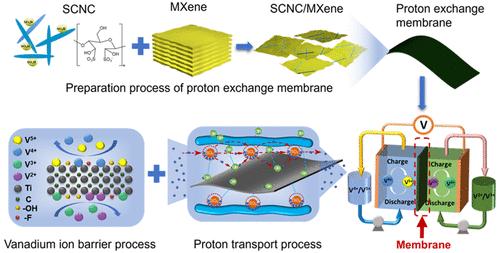磺化纤维素纳米晶/MXene杂化质子交换膜的制备及其在钒氧化还原液流电池中的协同作用
IF 9.1
1区 材料科学
Q1 CHEMISTRY, MULTIDISCIPLINARY
引用次数: 0
摘要
钒氧化还原液流电池(VRFB)是一种具有吸引力的可再生能源存储和输出技术,而质子交换膜是决定电池性能的关键部件。本研究通过将磺化纤维素纳米晶体(SCNC)/MXene杂化物掺入聚偏氟乙烯-共六氟丙烯(PVDF-HFP)聚合物基体中,设计并制备了一种质子交换膜,其钒渗透率为4.92 × 10-9 cm2 min - 1,质子电导率为15.8 mS cm-1,离子选择性为3.21 × 106 S min cm-3。SCNC与MXene纳米片的协同作用显著提高了VRFB的性能,在电流密度为40-120 mA cm-2时,库仑效率从97.0%提高到98.2%,电压效率从83.07%提高到93.44%,能量效率在81.6%到90.7%之间,优于商品化的Nafion 212膜。SCNC/MXene/PVDF-HFP混合膜具有综合优异的电池性能,使其成为vrfb中质子交换膜的有希望的候选者。本文章由计算机程序翻译,如有差异,请以英文原文为准。

Fabrication of Sulfonated Cellulose Nanocrystal/MXene Hybrid Proton Exchange Membrane and Its Synergistic Effect in Vanadium Redox Flow Battery
The vanadium redox flow battery (VRFB) is an attractive technique for renewable energy storage and output, and the proton exchange membrane is the vital component that determines battery performance. In this work, by incorporating sulfonated cellulose nanocrystals (SCNC)/MXene hybrids into a polymer matrix of poly vinylidene fluoride-co-hexafluoropropylene (PVDF-HFP), a proton exchange membrane was designed and fabricated, possessing a low vanadium permeability of 4.92 × 10–9 cm2 min–1, improved proton conductivity of 15.8 mS cm–1, and ion selectivity of 3.21 × 106 S min cm–3. The synergy between SCNC and the MXene nanosheet significantly elevates VRFB performance, yielding coulomb efficiency from 97.0% to 98.2%, voltage efficiency from 83.07% to 93.44%, and energy efficiency between 81.6% and 90.7% at a current density of 40–120 mA cm–2, which are better than those of the commercial Nafion 212 membrane. The SCNC/MXene/PVDF-HFP hybrid membrane presents comprehensive superior battery performances, positioning it as a promising candidate for proton exchange membranes in VRFBs.
求助全文
通过发布文献求助,成功后即可免费获取论文全文。
去求助
来源期刊

Nano Letters
工程技术-材料科学:综合
CiteScore
16.80
自引率
2.80%
发文量
1182
审稿时长
1.4 months
期刊介绍:
Nano Letters serves as a dynamic platform for promptly disseminating original results in fundamental, applied, and emerging research across all facets of nanoscience and nanotechnology. A pivotal criterion for inclusion within Nano Letters is the convergence of at least two different areas or disciplines, ensuring a rich interdisciplinary scope. The journal is dedicated to fostering exploration in diverse areas, including:
- Experimental and theoretical findings on physical, chemical, and biological phenomena at the nanoscale
- Synthesis, characterization, and processing of organic, inorganic, polymer, and hybrid nanomaterials through physical, chemical, and biological methodologies
- Modeling and simulation of synthetic, assembly, and interaction processes
- Realization of integrated nanostructures and nano-engineered devices exhibiting advanced performance
- Applications of nanoscale materials in living and environmental systems
Nano Letters is committed to advancing and showcasing groundbreaking research that intersects various domains, fostering innovation and collaboration in the ever-evolving field of nanoscience and nanotechnology.
 求助内容:
求助内容: 应助结果提醒方式:
应助结果提醒方式:


